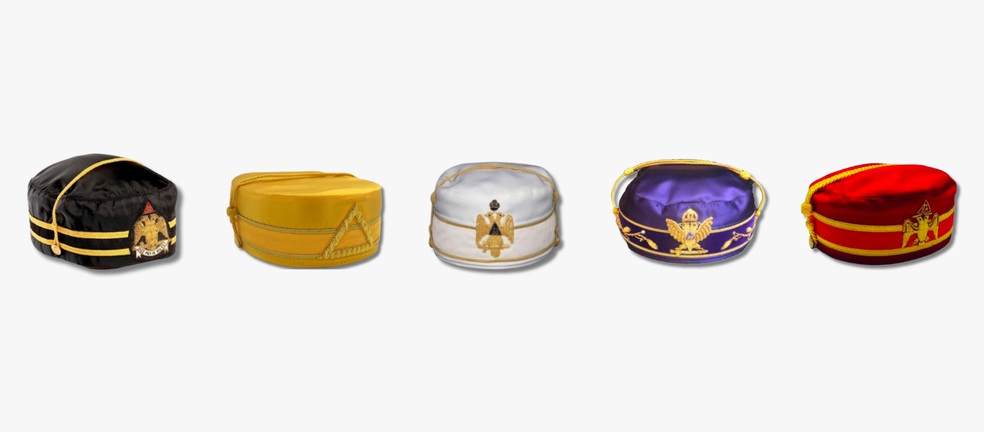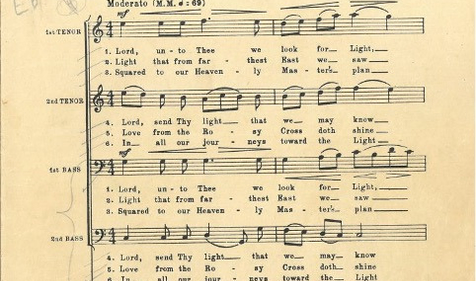Curious about the meaning behind our Scottish Rite caps? Learn about the significance of these Masonic caps and what they mean to Brothers traveling through the Craft in our blog.
Have you ever wondered what the Scottish Rite, Nothern Masonic Jurisdiction (NMJ) caps represent? There are various caps a Scottish Rite Freemason can wear, with each unique cap signifying a Brother’s rank or distinction in our Craft. In the NMJ, the wearing of caps is optional and is decided at the Valley level. Today, we invite you to explore the history behind the Scottish Rite regalia and dive deeper into the significance each cap holds.
The Symbolism of Scottish Rite Caps
At its core, Scottish Rite caps are a symbol of pride and affiliation. They also serve as a reminder of the work completed on a Brother’s rough ashlar thus far, displaying honors bestowed upon them through an embroidered Masonic symbol on the front of the cap.
How to Wear a Scottish Rite Cap
Scottish Rite caps are most often worn by Supreme Council or Valley officers, as well as Brothers who have demonstrated a commitment to our Craft through many years of affiliation and/or service. It is often considered proper to wear the caps at Reunions, Scottish Rite meetings, or other fraternal events like Maundy Thursday services.
In the Northern Masonic Jurisdiction (NMJ) the caps can only be worn by Scottish Rite Masons who have received the 32°. However, as noted in the Constitutions, Valleys in the NMJ can decide whether or not caps are worn.
Types of Scottish Rite Caps
There are a variety of Scottish Rite caps available for 32° Masons to wear, ranging in color and meaning. Below, we outline the caps that can be found in the Scottish Rite, NMJ.
Please note that the images of the caps found below are used for illustrative purposes and may not wholly contain all design and symbolic elements described in the Scottish Rite, NMJ’s Constitutions.
Lodge of Perfection cap
The Lodge of Perfection degrees are often referred to as “ineffable” degrees as they focus on the ineffable, or unutterable, name of God and include the 4°-14°. The Lodge of Perfection cap includes a simple triangle, with a JOD symbol thereon. Elected officers of a Valley’s Lodge of Perfection wear this particular Scottish Rite cap.
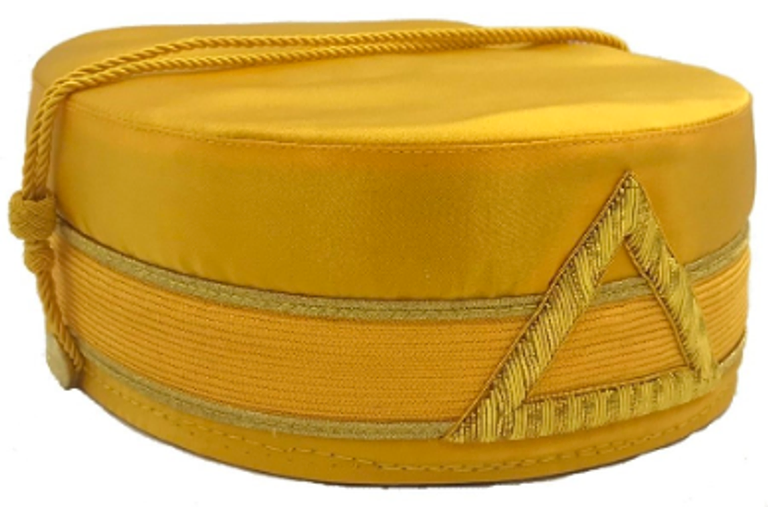
Council of Princes of Jerusalem Cap
The Council of Princes of Jerusalem consists of the 15° and 16° degrees, known as the historical degrees. These two degrees explore the conflicts and politics in the rebuilding of the Temple of Solomon. Elected officers of the Council of Princes of Jerusalem may receive this Scottish Rite cap. The cap includes a balance, with D and Z thereon.
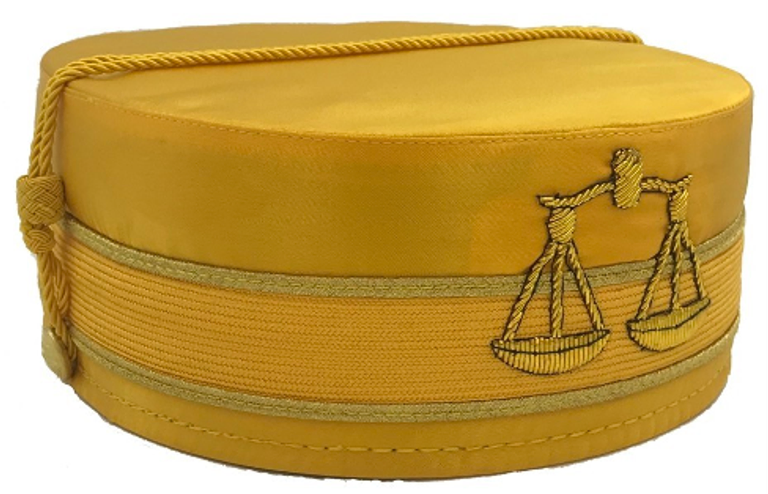
Chapter of Rose Croix Cap
Known as the philosophical degrees, the 17° and 18° degrees make use of Christian symbols and historical settings. Their spiritual message is universal for all Masons, who are united in the belief of a Supreme Being. The term “Rose Croix” means “rose cross” and is derived from the symbol of the Rosicrucians: a rose on a cross. When a Brother is elected to an officer position in the Chapter of the Rose Croix, a Brother will receive the gold cap with the “rose cross” embroidered on it.
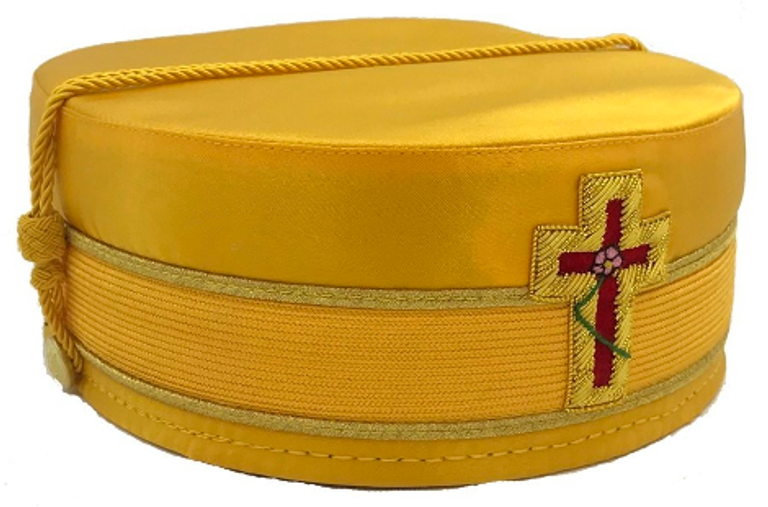
Consistory Cap
The Consistory cap represents the subordinate body that confers the 19°-32°. The degrees of the Consistory contain timeless lessons on social and moral conflicts that are taught through allegories in a wide variety of historical settings. Elected Consistory officers wear this yellow cap bearing the double-headed eagle, also the emblem of Scottish Rite Freemasonry.
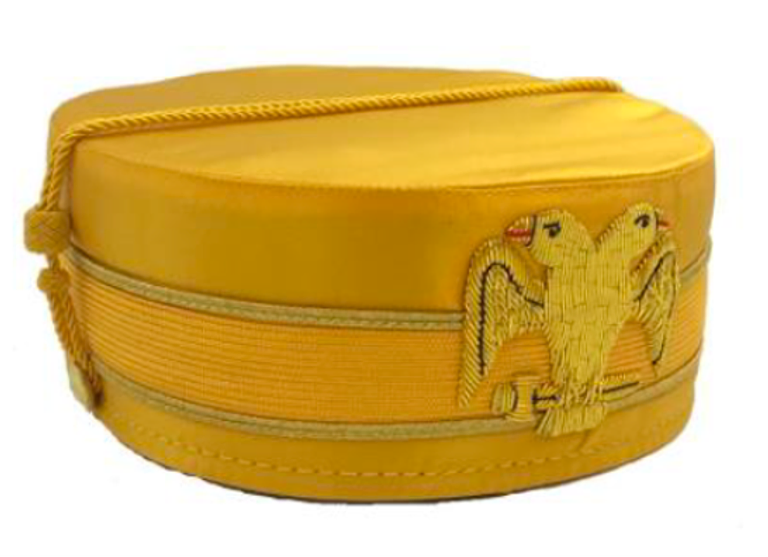
Scottish Rite 32° Degree Cap
The Scottish Rite 32° Degree cap is one of few caps available to non-officer Brothers. The 32° cap is worn by Brothers who have received a minimum of five Scottish Rite degrees, including the 4° and 32°.
This cap is round with striped black and gold bands around the sides of the cap. At the center, there is an applied gold bullion symbol of a double-headed eagle standing on a sword draped with a white banner reading “Spes Mea In Deo Est,” which means “my hope is in God.” Above the eagle’s heads is a red triangle with gold “32”.
Ill. Brother Sidney R. Baxter, 33°, who served as assistant to six Sovereign Grand Commanders of the Northern Masonic Jurisdiction between 1952 and 1997, wore the cap shown below for many years.
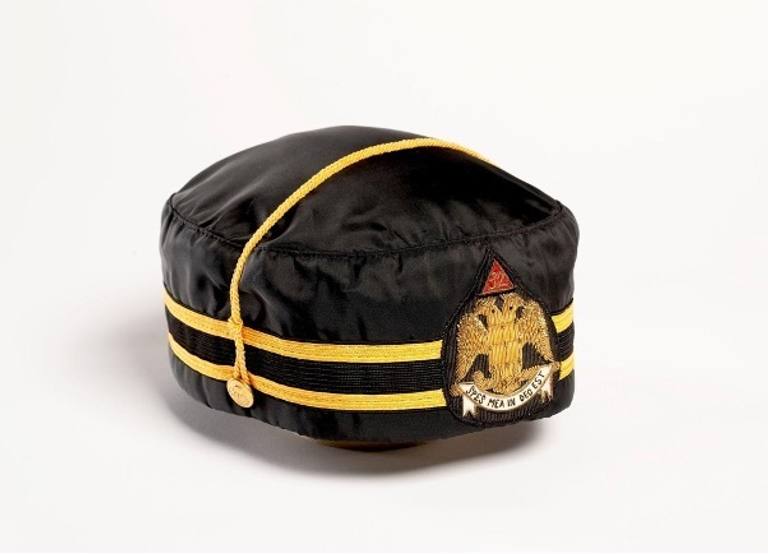
Masonic Scottish Rite 33° Degree Cap
In Scottish Rite Freemasonry, a Brother may be elected by the Supreme Council to receive the honorary 33° distinction. The 33° is an honor bestowed upon members who have exhibited outstanding service to the Brotherhood, and in recognition of accomplishments in private life, business, government, and the arts, as well as leadership and service within the fraternity.
This 33° cap, according to the NMJ’s Constitutions, “shall be made of heavy white grosgrain silk, with band of white silk velour without embroidery of laurel vine… and the double-headed eagle shall have the wings outspread and pointing downward.”
Former astronaut and US Senator John H. Glenn Jr. was made a Mason at sight in 1978. Twenty years later the soon-to-retire senator received the 33° of Scottish Rite Freemasonry. This cap bears the double-headed eagle emblem of the 33° on the front. On the inside, Glenn’s name is embroidered into the purple lining to help distinguish his cap from many others kept for safekeeping at the Valley of Cincinnati. The cap is now on long-term loan at the Scottish Rite Masonic Museum & Library in Lexington, MA.
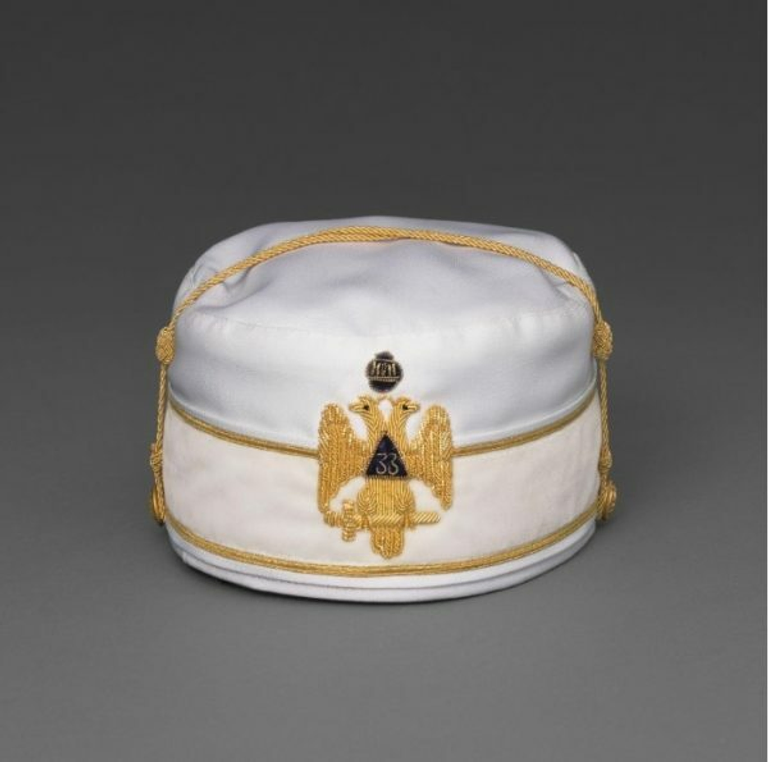

Meritorious Service Award Cap
The Meritorious Service Award (MSA) is given to those who have attained the 32° and who, by reason of meritorious service of a Masonic character are deemed worthy of such recognition. These members are distinguished by their red caps. According to the NMJ’s Constitutions, these caps have the same specifications as Honorary Members except “that rayon braid be used instead of velour and the color be red velvet and in the place of “33°’’ in the Triangle there shall be the letters ‘M.S.A.’”
A Valley’s Council of Deliberation selects those who are to receive this award and cap.
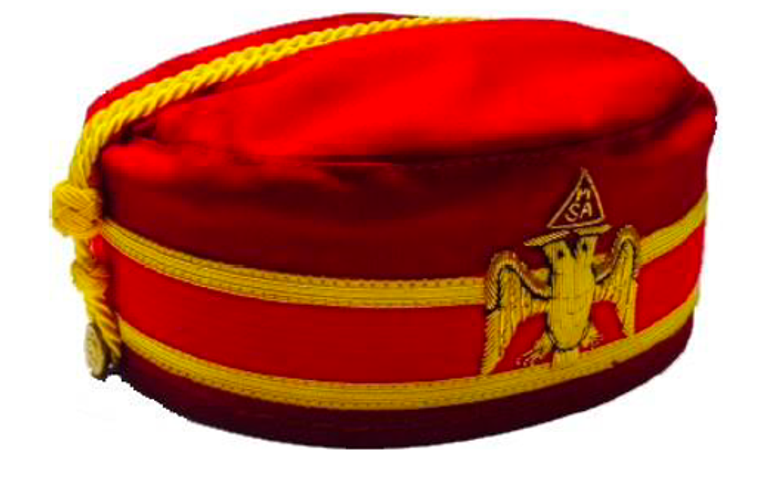
Scottish Rite Supreme Council Cap
The Supreme Council is currently composed of Active Members. Within the Scottish Rite, Northern Masonic Jurisdiction, each of the 15 states has an Active Member designated as a Deputy. The Deputy is supported by the remaining Active Members of the state and represents the Supreme Council in such State. The Active Members of the Supreme Council are distinguished by their purple caps.
As noted in the NMJ’s Constitutions, caps for Active Members:
“shall be of a circular style, with soft crown, about three and one-half inches high, made of heavy purple grosgrain silk. The band shall be of purple silk velvet one and one-half inches wide. A cord welt shall be placed above and below the band. One row of one and one-half ligne No. 2079 gilt vellum wire lace shall be placed at both top and bottom of band, leaving an interval of one and three-eighths inches of band showing between the lace. The velvet band shall be embroidered with a laurel vine in leaf and berry pattern in No. 26 and No. 27 fine gilt bullion. In the center of the front of the cap shall be superimposed a double-headed eagle in gilt cord with wings outspread and pointing upward, on the center of which shall be a triangle of purple velvet, with the numerals “33°’’ in gilt cord. The eagle shall be crowned with a small crown of purple velvet and gold bullion….The name of the Active Member shall be embroidered with yellow thread in the inner lining of the cap, which cap shall remain the property of the Active Member.”
Notice the double-headed eagle emblem has its wings pointing up instead of down – this is a distinction reserved for Active Members only.
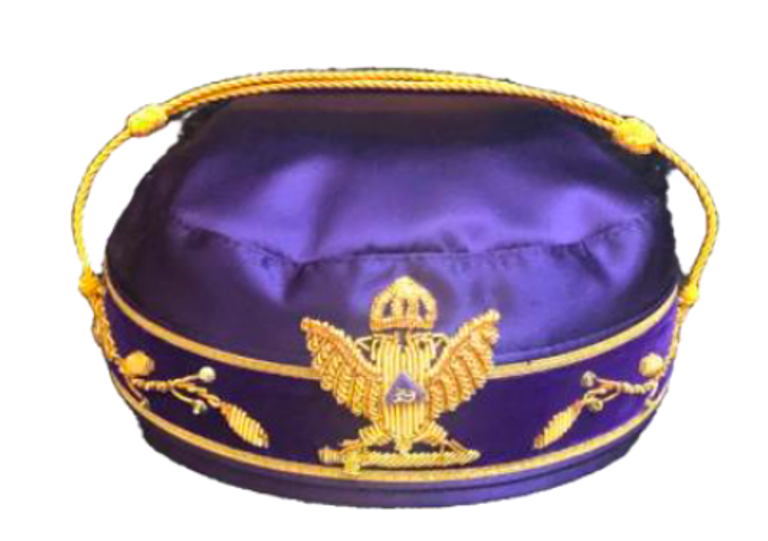
Interested in Learning More?
For Brothers that are interested in learning more into the symbolism of the Scottish Rite caps, we recommend that you read Wings Up or Wings Down?: Using Books to Find An Answer. This has been published by the Scottish Rite Masonic Museum & Library and is a great resource on the meaning behind the double-headed eagles on the Scottish Rite caps.
Related Stories
Discover additional Scottish Rite blogs and news on this topic.
